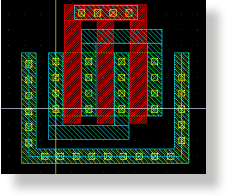|
Characterization of deep submicron CMOS technologies
|
 |
|
|  |
G. Gaioni, M. Manghisoni, L. Ratti, V. Re,
V. Speziali,
G. Traversi
|
|
|
Deep submicron CMOS technologies are today widely used in mixed-signal
front-end systems. They provide the required integration density and
are very promising in terms of radiation hardness. As far as analog
performances are concerned, the trend toward device scaling brings
along the need of understanding the noise properties of transistors
with channel length of a few tenth of a micron. In the framework of
this research program, an accurate model for the noise behavior of
deep submicron CMOS devices has been developed, paying particular
attention to short-channel effects and to parasitic contributions from
gate and substrate resistors.
|

|
|
The model has been assessed through an
extensive comparison with experimental results. Devices belonging to a
BiCMOS process with minimum channel length of 0.35 um and to a
CMOS process with minimum length of 0.18 um were
characterized. Noise measurements have been carried out by means of a
purposely developed wide band transimpedance amplifier. High density
front-end systems are designed according to low-power criteria. It is
therefore most important to predict the noise performance of the
devices at small overdrive voltages. The study of the experimental
noise data relevant to P and N-channel MOSFETs working in this
operating region may provide effective tools to the design of
low-noise, low-power analog blocks. CMOS transistors belonging to the
two mentioned technologies have been exposed to gamma-rays from a
60-Co source and changes in static, signal and noise parameters
have been monitored.
|
|
|
|

